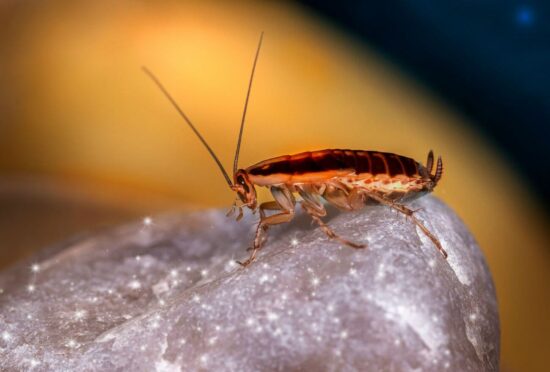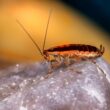If you’ve ever wondered “can roaches bite,” you’re not alone. This question keeps many people up at night, especially if they’ve spotted these unwelcome visitors in their home.
Let’s dive into everything you need to know about cockroach bites, when they might occur, and what you should really be worried about instead.
The Truth About Roach Bites
Cockroaches are omnivores that eat plants and meat. They have been recorded to eat human flesh of both the living and the dead, although they are more likely to take a bite of fingernails, eyelashes, feet and hands. But before you start panicking, remember that cockroach “bites” on humans have only been recorded a few times throughout history.
Think of it this way: cockroaches are like the ultimate opportunists of the insect world. They’ll eat almost anything, but humans aren’t exactly on their preferred menu. Cockroaches are not likely to bite living humans, except perhaps in cases of extreme infestations where cockroach populations are large, especially when food becomes limited.
Most of the time, what people think are roach bites turn out to be something completely different. It could be an allergic reaction, another type of bug bite, or even a skin condition that has nothing to do with insects at all.
How Cockroach Mouths Actually Work
To understand whether roaches can bite effectively, we need to look at their anatomy. Cockroaches have primitive insect mouthparts for biting and chewing. They consist of mandibles, maxillae, labrum, labium, and hypopharynx. The mandibles are essentially their “jaws” made for cutting, crushing, and chewing food.
These mandibles are surprisingly strong. One study found that the common American cockroach can bite with a force around 50 times its body weight, up to a maximum force of 0.5N. That sounds impressive until you realize that the force required for a needle to puncture skin is in the range of 1–10N. This means cockroaches struggle to break through human skin under normal circumstances.
“Their mouthparts just cannot pierce human skin,” says Dini Miller, Ph.D., professor of urban entomology at Virginia Tech and Urban Pest Management Specialist for the state of Virginia. Instead of puncturing like a mosquito, cockroaches bite and chew laterally (side to side) with sharp mouthparts that pierce and suck. This cutting action might cause minor scrapes or irritation, but it’s very different from a typical insect bite.
When Cockroach Bites Actually Happen
So when might cockroaches actually bite people? It comes down to desperation and opportunity. When cockroach numbers are left unchecked, the population may outgrow the normal food sources. Once the food becomes limited, the cockroaches will be forced to forage more and on things they would not normally consume.
Historical Cases from Ships
The most well-documented cases of cockroach bites come from ships. The most serious cases of cockroaches biting humans have been on ships. It has been documented that some cockroaches on seafaring vessels have become so numerous that they gnawed the skin and nails of those on board. Some sailors even reported wearing gloves so that the cockroaches would not be able to bite their fingers.
A scientific review by Roth and Willis (1957) describes severe infestations on ships in which famished cockroaches would gnaw on the fingernails and skin of sailors as they slept. These extreme conditions, with hundreds of people crammed into small spaces with limited food and poor sanitation, created the perfect storm for desperate cockroaches.
Modern Cases
In today’s world, documented cockroach bites are incredibly rare. The most recent documentation of cockroach “bites” has been in low-income housing where babies go to sleep at night with food remnants on their mouths, which the cockroach might crawl up and start trying to eat. Even these cases are more about cockroaches trying to clean up food residue than actually attacking humans.
Many reported cockroach bites are on children’s faces, usually around the mouth. This leads researchers to believe cockroaches are attracted to food residue on humans since infants and toddlers are more likely to have unwashed faces and hands.
What Do Cockroach Bites Look Like
If a cockroach actually did bite someone, what would it look like? Roach bites are bright red, raised bumps that are approximately 1-4 mm wide. They are typically slightly larger than a bed bug bite and generally only occur one at a time, while bed bugs will bite in clusters or lines.
The appearance can vary depending on the species. According to entomologist Josh Shoemaker, bites from Oriental cockroaches have been documented to cause inflammation and necrosis, while bites from German cockroaches may cause crusted ulcerations, scarring, and skin discoloration.
However, identifying a true cockroach bite is tricky because roach bites can be easily mistaken for other insects like bed bugs. The key differences are that cockroach bites usually appear alone rather than in groups, and they’re more likely to occur in areas where food residue might be present.
Cockroach Bites vs Other Bug Bites
Understanding how cockroach bites differ from other common household pests can help with proper identification:
Bed Bug Bites: Bedbug bites usually form clusters or lines, show up overnight, and target uncovered skin. They often appear in groups of three or more.
Mosquito Bites: Mosquito bites tend to be more scattered and appear after time outside. They’re usually random and isolated.
Cockroach Bites: Typically appear as single bumps, often near areas where food residue might be present, and are extremely rare overall.
The timing also matters. If a cockroach does bite a human, it will likely be while the person is asleep. This is largely due to the fact that cockroaches are nocturnal creatures, meaning that they’re more active at night.
Symptoms and Health Effects
If someone did experience a cockroach bite, what symptoms might they expect? The bites may cause irritation, lesions and swelling. Some have suffered from minor wound infections. A cockroach bite may cause skin irritation and swelling. It may also become itchy.
The good news is that roach bites are generally nothing to worry about physically. Unlike mosquitoes or ticks, roaches do not transmit diseases through their bites. The main concerns are:
- Local skin irritation
- Risk of secondary infection from scratching
- Allergic reactions in sensitive individuals
Some people react to a protein found in cockroach saliva. This may cause increased swelling and itchiness. In very rare cases, severe allergic reactions involving anaphylaxis may occur. If you start to notice signs of low blood pressure, difficulty breathing, or other severe symptoms, seek immediate medical attention.
The Real Problem: Cockroach Allergies
Here’s what most people don’t realize: the biggest health concern with cockroaches isn’t bites at all. It’s allergies. Studies suggest that between 17% and 41% of people in the United States have cockroach allergies. That’s a much bigger problem than the handful of bite cases ever documented.
The saliva, feces and shedding body parts of cockroaches can trigger both asthma and allergies. These allergens act like dust mites, aggravating symptoms when they are kicked up in the air. Even more concerning, the National Pest Management Association reports that 63% of homes in the United States contain cockroach allergens. In urban areas, that number rises to between 78% and 98% of homes.
Allergy Symptoms
For people with sensitive skin or allergies, the debris left behind by cockroaches (including feces, shed skins and other particles) can cause an allergic reaction. These reactions are often mistaken for insect bites, but they’re actually caused by breathing in or touching cockroach particles.
Common symptoms include:
- Sneezing and runny nose
- Itchy, watery eyes
- Skin rashes and irritation
- Coughing and wheezing
- Asthma attacks
The connection between cockroaches and asthma is particularly strong in children. One study showed that kids who were allergic to cockroaches were hospitalized for asthma 3.3 times more often than other children.
Treatment for Cockroach Bites
If someone suspects they have a cockroach bite, treatment is straightforward. Start by cleaning the bite with warm, soapy water so that infection does not develop. Then you can work on controlling the symptoms. Reduce swelling by using an ice pack, applying aloe vera gel, or discussing with a doctor about using hydrocortisone cream.
For itching and discomfort:
- Apply cold compresses
- Use over-the-counter antihistamines
- Try topical anti-itch creams
- Keep the area clean and dry
- Avoid scratching to prevent infection
Most importantly, it is important not to scratch roach bites so that you do not develop a secondary infection.
Prevention: The Best Strategy
Since cockroach bites are so rare, the focus should be on preventing infestations altogether. Roach bites are generally nothing to worry about physically, but they definitely could be a sign of a large infestation that you were unaware of.
Keeping Cockroaches Away
The best prevention strategy targets what cockroaches need to survive: food, water, and shelter.
Remove Food Sources:
- Store food in sealed containers
- Clean up crumbs and spills immediately
- Don’t leave dirty dishes out overnight
- Keep pet food sealed
Eliminate Water Access:
- Fix leaky pipes and faucets
- Wipe down sinks and counters
- Use exhaust fans in humid areas
- Empty water from plant saucers
Block Entry Points:
- Seal cracks around windows and doors
- Fill gaps around pipes and wires
- Keep clutter to a minimum
- Regular cleaning and vacuuming
Debunking Common Myths
Let’s clear up some misconceptions about cockroach bites:
Myth: Cockroaches regularly bite humans as part of their normal behavior. Fact: “They don’t have any reason to,” says Dini Miller, Ph.D., professor of urban entomology at Virginia Tech.
Myth: If you have cockroaches, you’ll definitely get bitten. Fact: Incidents of cockroaches biting people are rare. In fact, I’ve only heard of it happening a few times throughout my pest control career, says Timothy Wong, technical director of MMPC.
Myth: Cockroach bites spread diseases. Fact: Unlike mosquitoes and ticks, cockroaches don’t transmit diseases through bites. The health risks come from contamination and allergies.
Myth: All skin reactions around cockroaches are from bites. Fact: Most reactions are actually allergies to cockroach debris, not bites.
When to Worry and When to Relax
So when should you actually be concerned about cockroach bites? The honest answer is almost never. “But a lot of these types of reports are very anecdotal and unsubstantiated,” says research from the Schal Lab at North Carolina State University, which focuses on the study of cockroaches.
If you find yourself asking “can roaches bite” because you woke up with mysterious bumps, consider these more likely explanations first:
- Bed bugs (if bites are in clusters)
- Mosquitoes (if you were outside recently)
- Allergic reactions to cockroach debris
- Other skin conditions unrelated to insects
- Different household pests like fleas or mites
The real concern should be the presence of cockroaches themselves, not the tiny possibility of bites. Focus on elimination and prevention rather than worrying about getting bitten.
The Bottom Line
Can roaches bite? Yes, technically they can. Will they bite you? Almost certainly not. Cockroaches typically do not bite people unless extreme conditions like starvation or overpopulation force them to.
The documented cases of cockroach bites throughout history involve extreme circumstances that most people will never encounter. Modern homes with normal levels of food availability and reasonable pest control practices create an environment where cockroach bites are virtually impossible.
Instead of losing sleep over the possibility of roach bites, focus on the real health concerns: allergies and contamination. A good cleaning routine, proper food storage, and prompt treatment of any cockroach problems will address these actual risks while also eliminating any microscopic chance of bites.
Remember, cockroaches are more afraid of you than you are of them. They’re not looking to pick a fight or feast on human flesh. They just want to find some crumbs, water, and a dark place to hide. Keep your home clean, seal up entry points, and deal with any infestations quickly. That’s the best strategy for staying healthy and bite-free.
If you’re still concerned about mysterious bumps or skin reactions, talk to a healthcare provider for proper diagnosis. They can help determine if you’re dealing with cockroach allergies, other pest issues, or something completely unrelated to insects. But rest easy knowing that actual cockroach bites remain one of the rarest pest problems you’ll likely never have to face.


